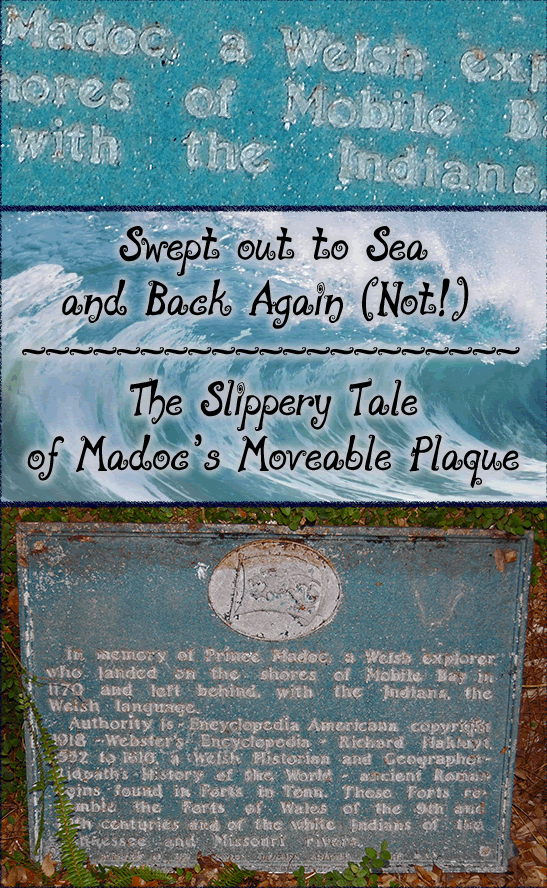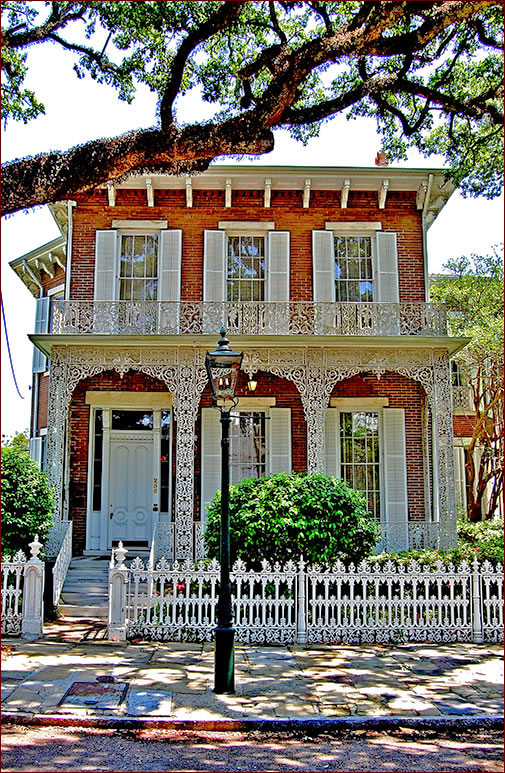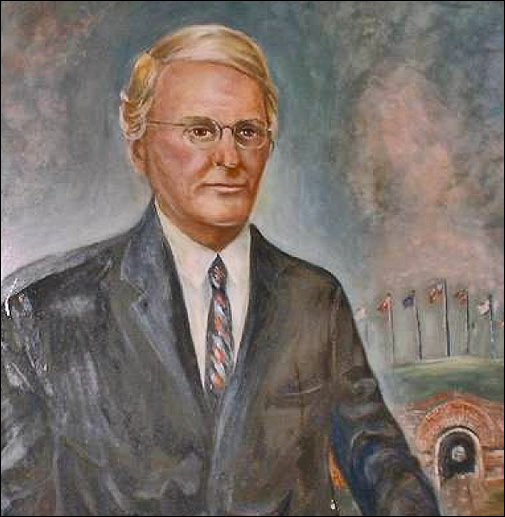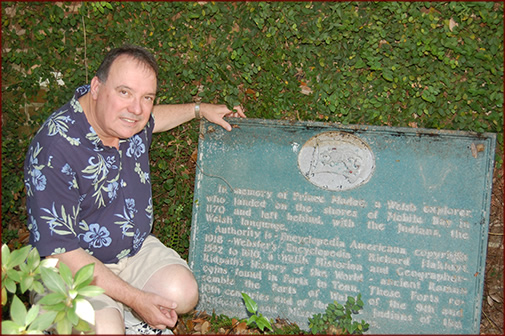 |
The notorious Madoc Plaque, now on display in Mobile, Alabama
It's Pseudohistory for Sure,
But Worth Its Weight in Stories to Tell.
Finding Old Madoc
At the DAR in Mobile
By Ron Fritze from Athens, Alabama
Filed on May 7, 2012
Posted on August 15, 2012
Twylia and I took a little trip last spring. I was scheduled to give a Road Scholars lecture for the Alabama Humanities Foundation at the town of Greenville, which is about 45 miles south of Montgomery on I-65. We decided it would be nice to make the two-hour drive beyond Greenville and visit Mobile. Twylia’s parents had lived in Mobile before she was born, and her mother had fond memories of the city. So Twylia was interested in seeing Mobile.
As for me, I had recently read that the plaque commemorating the landing of Prince Madoc and the medieval Welsh at Fort Morgan on Mobile Bay was back in the possession of the Daughters of the American Revolution (DAR) chapter that had erected it in 1953. I have been trying to see this plaque for twenty years, so that was one more reason to visit Mobile. I contacted the DAR headquarters in Mobile, and a very helpful woman named Sallie Grow told me that they did have the plaque. I had read it was on display in the garden of the DAR house, but she informed me that it was actually in storage in the carriage house. Not a problem as they were happy to show it to me.
We left on a Friday afternoon in late April for Montgomery, where we intended to stay the night. In the course of his many business trips to Montgomery, Bob Glenn, the president of Athens State University, had discovered the Hampton Inn in the old downtown near the state government buildings and introduced me to it on one of our trips. Originally the Hampton Inn had been the Greystone Hotel, which was a fine old historic hotel in a sort of Italianate or Renaissance style of architecture. The Hampton Inn, operated by a very friendly staff, is well-run with comfortable rooms, a good fitness center, and a nice complimentary breakfast. I wanted to show the place to Twylia. She enjoyed staying there quite a bit.
The next morning after breakfast we got on the road a bit before 8:30. That got us to Greenville at 9:15. My friend Frazier Douglass had told me about a really fine barbeque place in Greenville. Herbert Morton, the man who invited me to speak at Greenville, confirmed that the place in question, The Real Pit BBQ, was a great place for barbeque. But it did not open until 10:30, and then when we came back to Greenville the next day, it wasn’t open because it is closed on Sunday and Monday. We needed to push on to Mobile, but we’re planning on coming back to Greenville and try out the Real Pit.
256 North Joachim in Mobile: The Richards House
Photo by Ron Fritze ~ April 28, 2012
A Place of Charm and Beauty
It is about a three-hour drive from Montgomery to Mobile. You can stay on I-65 the whole way. We got to Mobile a little after 11 and headed straight for the Richards House, which is the combined headquarters of three DAR chapters.
The Richards House is located in the northern section of Mobile’s historic district in an area of fine big houses situated along wooded streets with trees covered in Spanish moss. The neighborhood’s charm and beauty reminds me of New Orleans. Charles Richards, a steamboat captain and a merchant, built the Richards House in 1849 to be the dream home for him and his wife. Architecturally it is Italianate with a large side garden and a very pretty garden in the back. The house was later purchased by the Ideal Cement Company, which restored it in 1947 for use as offices and guest accommodations. In 1972 the company gave the house to the city of Mobile which, in turn, lets the three DAR chapters use the house. The house is a popular venue for weddings, receptions, and other social gatherings. The day we visited the Richards House, preparations for a wedding reception were underway.
At the Richards House:
(from left) Twylia, Mary McDonald, and Margaret Odom
April 28, 2012
Old Fashioned Southern Hospitality
From the Ladies of the DAR
The DAR people were expecting us, thanks to Sallie Grow. So, parking on the street, we walked up to the front door and knocked. We were greeted by a friendly lady named Mary McDonald, who took us to the back of the house where she brought a second woman, Margaret Odom, to meet us. Margaret is a member of the Virginia Cavalier chapter of the DAR, which is the chapter that originally erected and now once more possesses the Madoc plaque. We went out to the back garden where the plaque was leaning against the wall of the carriage house. The DAR has recently put a nice new floor down in the carriage house, so the plaque was put outside. It is larger than I had imagined as you can see from the picture at the bottom of this page.
If you are not familiar with Madoc and Welsh Indian lore, there is a belief that a Welsh prince named Madoc sailed west about 1170 to escape civil war and turmoil in Wales. On that voyage he discovered a previously unknown western land. It was America, in particular North America. There are various claims about where Madoc was supposed to have landed, ranging from Newfoundland in the north to the mouth of the Amazon River in the south and all points in between. A particularly popular location for the Welsh landing is Mobile Bay at the site of Fort Morgan.
Hatchett Chandler
Source:
http://www.rootsweb.ancestry.com
Was It a Hatchet Job on History?
The man who did the most to popularize the Mobile Bay version of the Madoc story was Hatchett Chandler (1881-1967), a businessman with an interest in history. His greatest passion was Fort Morgan, which he wanted preserved. In somewhat of an informal fashion he became the unofficial caretaker of the Fort around the time of World War II. His position was later formalized, and Chandler held it until 1957. Besides being a first-class showman in the tours of the Fort that he hosted, he wrote a book, Little Gems of Fort Morgan: Cradle of American History (1953), which contained many anecdotal tales of Fort Morgan, including the account of Prince Madoc landing there. That year he also managed to persuade the Virginia Cavalier chapter of the DAR to erect the plaque commemorating the landing of Madoc and the Welsh at Fort Morgan. When Chandler died in 1967, he was buried at his beloved Fort Morgan.
The plaque remained but was an embarrassment to the professional staff of the park service since it espoused a patently pseudohistorical theory. When Hurricane Frederic struck the Gulf Coast in 1979, the Madoc plaque’s mounting was damaged. The apparently relieved Park Service put the now unwelcome plaque into storage. I did not know this fact when I visited Fort Morgan in the early 1990s and inquired about the plaque’s whereabouts. A female ranger told me it had been swept out to sea. That was a big disappointment, particularly in light of the soaking we got crossing the entry to Mobile Bay on the ferry.
I got back to Fort Morgan in 2008 (see the CornDancer essay about this trip) and this time I was told the truth: the plaque was in storage. Then in the spring of 2010, John Hall, a well-recognized authority on Alabama history, wrote an article about the Madoc myth for Alabama Heritage. From this article I learned that the Park Service had faced persistent agitation and finally a petition from supporters of the Madoc story to re-erect the Madoc plaque at Fort Morgan. Repeated unwelcome queries about the Madoc plaque may have been the reason the park ranger appears to have lied to me in the early nineties. The solution of the Park Service was to give the plaque back to the Virginia Cavalier chapter of the DAR.
Personally, I think that years ago the Park Service should have placed the plaque in their museum at Fort Morgan with a nice display discussing the pros and cons of the Madoc story. I’m a skeptic, but I think the public deserves a presentation based on the evidence. Yes, the Park Service would most likely argue that the Madoc story is a myth without basis in historical fact. Let the people assess the evidence and decide on their own. I agree that the existence of a medieval Welsh colony is a fabricated myth, but I would further argue that the Madoc story has become part of the history and folklore of Fort Morgan and should be treated as such rather than ignored. For me, finally getting to see the Madoc plaque in person after a twenty-year quest was a real thrill.
Bedroom at the Richards House
Photo by Ron Fritze ~ April 28, 2012
A House and a City Rich in History
Afterward, Margaret took Twylia and me on a tour of the Richards House — and a fine old house it is. For its day, it would have been a rather large mansion. The DAR have decorated it beautifully with period furniture, although only one piece, a piano, actually belonged to the Richards family. We were treated with the greatest hospitality by Margaret Odom and Mary McDonald. Although my original contact, Sallie Grow, could not be at the Richards House when we visited, she certainly ensured that we were well-taken care of. Mobile is a city full of history and culture, but the Richards House is well worth a visit in its own right.
After leaving the Richards House, we toured the historic downtown. Parking near Dauphin Street, we made our way to the Museum of Mobile, a fine place with nicely done exhibits ranging from prehistory to the present. While I knew that Mobile was founded by the French in the seventeenth century, hence its similarity to New Orleans, I did not realize that for some time it was a more important colonial city than New Orleans. Nor did I realize that it and not the Big Easy hosted the first Mardi Gras. In fact, Mobile continues to hold a Mardi Gras.
Welcome to the Richards House
Illustration by Planet Clio
The Baked Oysters and Crab Soup
Were Absolutely Marvelous!
On the way to the museum we passed the Bienville Bookstore, a nice second-hand shop. Through a display window I spotted a book I wanted and told Twylia we’d stop at the Bienville on the way back to our parked car. And we did. Margaret and Mary had suggested we get seafood for dinner at Felix’s Fish Camp off the causeway near the Battleship Alabama. The woman working at the Bienville made the same suggestion. When all the locals are making the same restaurant recommendation, a prudent person listens — although this rule doesn't apply to recommendations about Cajun food outside of Louisiana or Mexican food outside of Texas and the Southwest. We made our way to Felix’s and enjoyed a marvelous meal. They serve a crab soup, and I’d put it on the list of one hundred things you need to eat in Alabama before you die. Extremely good! Twylia got some baked oysters that rivaled those of Gilhoolie’s on the mainland of Galveston Bay. So, if you are in Mobile, check out Felix’s for seafood and the Bienville Bookstore for used books. We stayed at a Hampton Inn in Saraland, a Mobile suburb. It was a typical modern building but a good place to stay with a friendly staff.
Sunday we drove to Greenville, about a two-hour drive. I was speaking to the Butler County Historical and Genealogical Society about the De Soto Expedition. In town, a member the society named Annie Crenshaw met us and took us to lunch at the clubhouse of the Cambrian Ridge golf course, which is part of the Robert Trent Jones Golf Trail. I am no golfer, but the course is a located on pretty wooded hills with lakes and ponds. The clubhouse is well appointed with very tasty food. Afterward Annie showed us a nice park in the area. Then we went to City Hall where the historical society meets on the fourth Sunday of each month. There I met Herbert Morton, who had invited me to speak. He, like Annie, was most hospitable, as was everyone with the society. And the talk went well.
Twylia and I found Greenville to be a very pleasant place with a quaint and historic downtown. Although its population is only 10,000, it impressed us as a great place to live. After my talk we visited with the members of the historical society and then got on the road back to Athens and home.
Our trip to Greenville will remain in my memory as one of the best times we've had on a trip for the Alabama Humanities Foundation — and all of the trips have all been quite good. When you throw in the comfort of the Greystone Hotel, the charm of Mobile, and the thrill of finally seeing the Madoc plaque, it was a marvelous time. I wish the same joy to all of you.
The Madoc plaque is no small item.

|

|
















 |
 |










